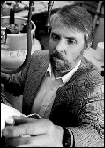
By ELLEN GOLDBAUM
News Services Editor
 The Center for Advanced Photonic and Electronic Materials (CAPEM), which
will absorb the activities of the Center for Electronic and
Electro-optic Materials (CEEM), while incorporating other research
activities in materials science involving faculty in the several
departments, has been created at UB.
The Center for Advanced Photonic and Electronic Materials (CAPEM), which
will absorb the activities of the Center for Electronic and
Electro-optic Materials (CEEM), while incorporating other research
activities in materials science involving faculty in the several
departments, has been created at UB. Bruce D. McCombe is director of the new research center, the work of which will incorporate activities of the departments of Chemical Engineering, Chemistry, Electrical and Computer Engineering, Mechanical and Aerospace Engineering and Physics.
Professor and former chair of the Department of Physics, McCombe conducts research on semiconductor physics and electronic materials. He was co-director of CEEM with Wayne A. Anderson. Anderson, professor and former chair of the Department of Electrical and Computer Engineering, is associate director of CAPEM.
The new center will foster collaborations on campus between researchers working on compound semiconductors, polymers and novel conductors including superconductors. "We want to create an environment in which people communicate, are aware of each other's work and depend on each other's participation," said McCombe.
A major reason for establishing the new center is to be able to improve researchers' chances of success when they apply for external funding from federal or other sources.
"We need to leverage our internal resources to get more from outside the university," said McCombe. "We can do that by making better use of the disparate efforts in materials science that are occurring on campus.
"Most of the individual researchers working in this area have been at least moderately successful, but to bring in a major grant in this funding environment almost requires that people work together," he explained.
For example, several research groups on campus are interested in funding the establishment of an atomic force microscope/scanning tunneling microscope facility. Several local companies also have expressed an interest in such a capability.
With a price tag for such a facility at about $250,000, an individual scientist would have a hard time justifying that purchase, McCombe said, noting that funding agencies would be more receptive if it were to be shared among several research groups.
CAPEM also will help coordinate interdisciplinary educational and instructional programs in materials science.
A Materials Research Instrument Facility will be established as part of CAPEM and will assume responsibility for the characterization instruments of the New York State Institute on Superconductivity, the new transmission electron microscope facility in 109 Furnas Hall, the Clean Room in 212A Bonner, the Cryogenics Facility in Fronczak Hall and the Thin Film/Surface Analysis facility in the Natural Sciences and Mathematics complex.
The new organization will be responsible for maintaining and acquiring scientific instruments in these facilities, as well as for developing funding strategies for them.
Joseph A. Gardella Jr., professor of chemistry, will be director.
The New York State Institute on Superconductivity will retain its separate identity under the direction of David T. Shaw, executive director. Faculty presently involved with the institute will be invited to participate in CAPEM.
A faculty executive committee has been established to advise the director of CAPEM on research strategy and center operations. Members are Triantafillos J. Mountziaris, associate professor of chemical engineering; Michael J. Naughton, associate professor of physics; Paras N. Prasad, professor of chemistry, and Shaw, who also is professor of electrical and computer engineering. McCombe, Anderson and Gardella will be ex-officio members.